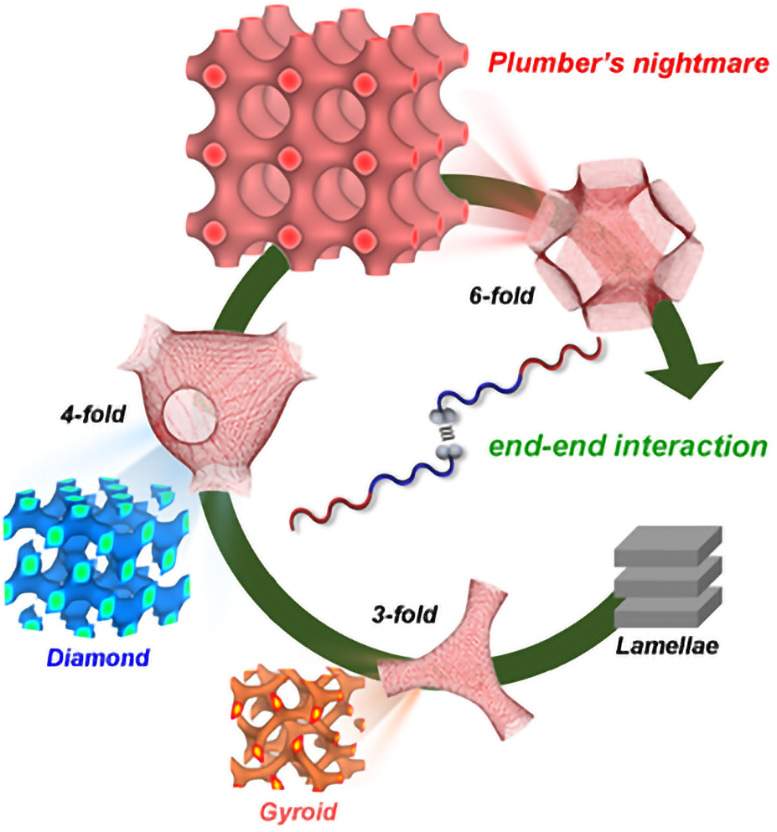
Researchers at POSTECH have successfully created the complex “plumber’s nightmare” structure in block copolymers, a groundbreaking achievement that paves the way for new applications in nano-technology and material science. This discovery demonstrates the potential for crafting diverse polymer nanostructures with tailored properties. (Artist’s concept). Credit: SciTechDaily
Plumber’s nightmare structure presents itself as an assemblage where all exits seem to converge inward—a plumber’s nightmare but an anticipated uniqueness for researchers, suggesting distinctive traits divergent from traditional materials. Nonetheless, this intricate configuration was deemed unattainable, bordering on the realm of the impossible.
Recently, a research team at Pohang University of Science and Technology (POSTECH) unearthed clues from neglected minuscule ends, transforming this dream into reality. The prestigious international journal Science not only published this research but also spotlighted it as an article, sparking considerable interest within academic circles.
Breakthrough in Nanostructure Research
Professor Moon Jeong Park and PhD candidate Hojun Lee from POSTECH’s Department of Chemistry brought to life nanostructures of block copolymers (hereafter BCPs), which were previously only envisioned. This study was recently published in the journal Science.
BCPs represent polymers constructed by linking blocks of one monomer with blocks of another. Capable of self-assembly, BCP’s craft diverse nanoscale structures, finding widespread applications across fields covering semiconductor and medicine. Recent studies have been vigorously exploring comparisons in optical and mechanical properties based on BCP structure. However, as structures grow more intricate, their thermodynamic stability diminishes, posing considerable challenges in their production.
The Plumber’s Nightmare Realized
Among these structures, the plumber’s nightmare, exhibiting medial packing of polymer chain ends, stands as an immensely complex and distinctive formation. While real-life instances of its manifestation were absent, it was hypothesized to possess unique optical and mechanical traits due to its distinctive channel structure, setting it apart from other nanostructures.
In this groundbreaking research, the team defied expectations by turning the impossible into possible. While most research has focused on the main polymer chains constituting BCPs, the researchers shift their focus to the inconspicuous, less than one percent, chain ends. They crafted di-end-functionalized BCPs by linking different molecules to each end of the polymer chain. Consequently, the polymer chain ends exhibited robust mutual attraction, causing all the polymer tails to coalesce inward, marking the team’s successful realization of the plumber’s nightmare structure, a world’s first achievement.
Expanding the Realm of BCP Structures
Furthermore, the team successfully produced a range of BCP structures that had hitherto remained enigmatic, including gyroid and diamond structures. This accomplishment in materializing BCP structures previously confined to the realms of imagination and theory stands as a significant feat.
Of particular note, this study’s significance lies in the conclusion that complex structures can be stably realized when potent forces exist at the ends, despite diverse adjustments made in BCP polymer composition and the main chain’s chemical properties. This suggests the universal applicability and adaptability of this research for future studies focused on developing diverse composite-structure polymer nanostructures.
Professor Alisyn J. Nedoma from the University of Sheffield, an expert in the BCP field, remarked in the Science commentary, “It lays the groundwork for designing novel BCP nanostructures,” assessing the potential cost-effectiveness in creating nanostructures with desired characteristics.
The study’s lead, Professor Moon Jeong Park explained, “This research has enabled us to establish a method for developing tailored network structures in polymer BCP. It will serve as a platform for crafting polymer BCPs with diverse properties in nano-technology applications.”
Reference: “Thermodynamically stable plumber’s nightmare structures in block copolymers” by Hojun Lee, Sangwoo Kwon, Jaemin Min, Seon-Mi Jin, Jun Ho Hwang, Eunji Lee, Won Bo Lee and Moon Jeong Park, 4 January 2024, Science.
DOI: 10.1126/science.adh0483
This work was conducted with support from the following programs under the National Research Foundation of Korea: Mid-Career Researcher Program, Creative Materials Discovery Program, and Science Research Center Program.










Be the first to comment on "Turning the Impossible Possible: Korean Scientists Have Created the Notorious Plumber’s Nightmare Structure"